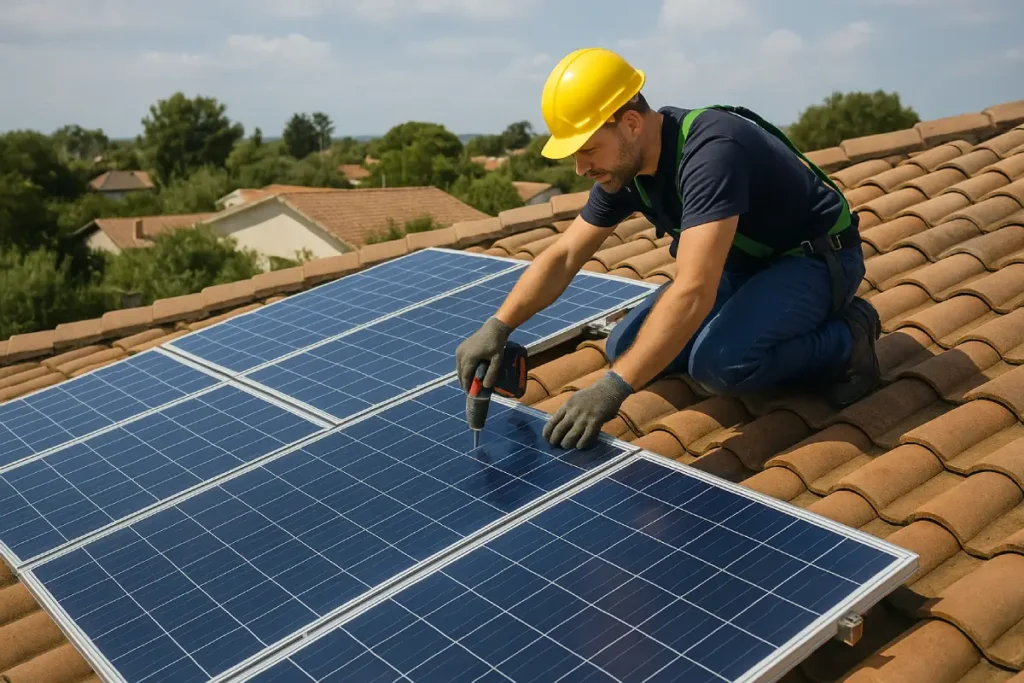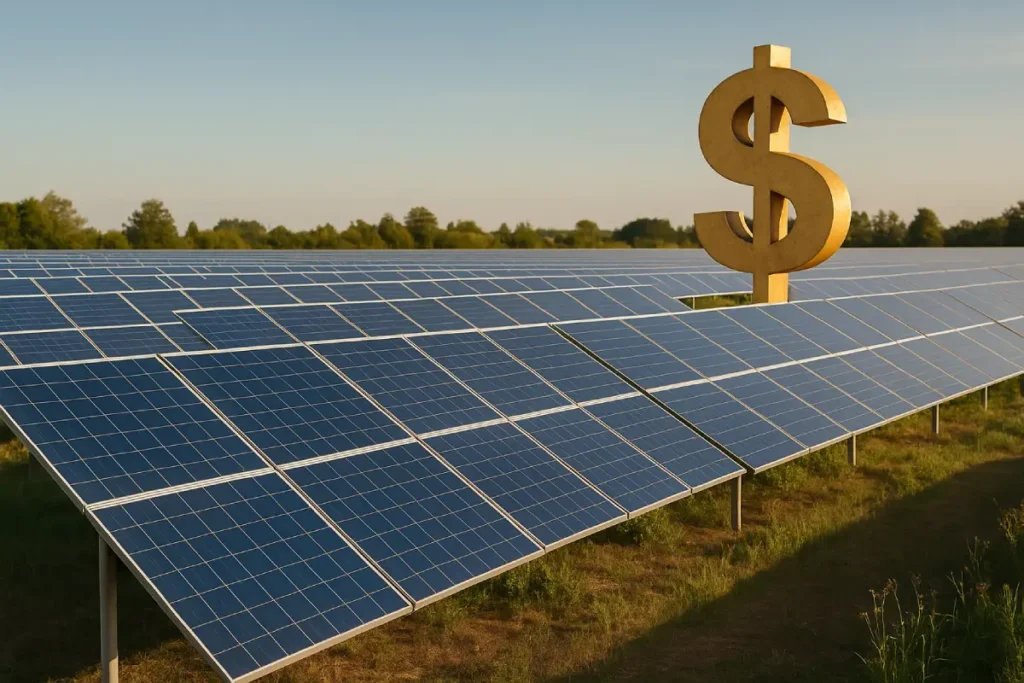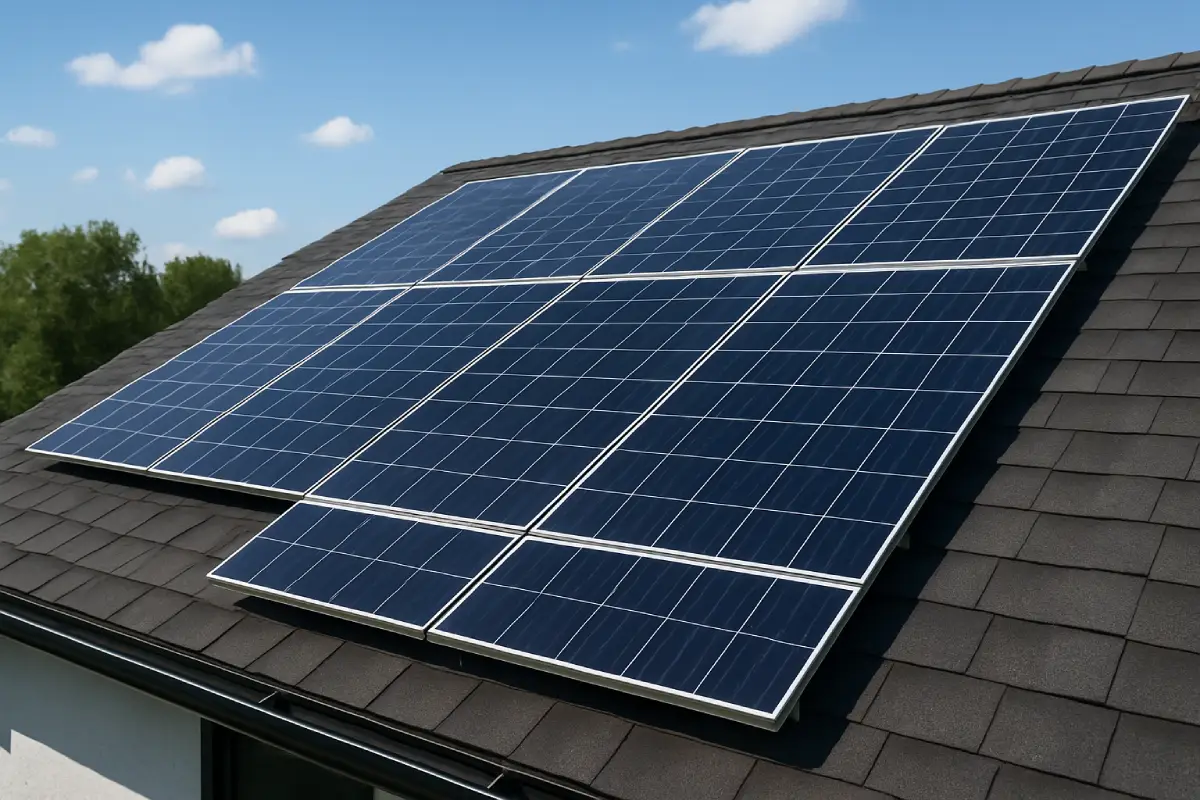Tesla Solar Roof costs around $63 per square foot, making it one of the priciest solar options available today. The product has been accessible to more people for several years, yet Tesla manages to install only about 23 roofs weekly in 2022—nowhere near their original targets. Homeowners who want to try this innovative option should learn about what a Tesla Solar Roof actually delivers before making such a big investment.
Tesla Solar Roof panels look better than traditional solar installations, but they don’t come cheap. Most installations cost over $100,000 based on roof size and complexity. The price tag runs about 75% higher than regular solar panel systems. The system can handle wind speeds up to 110 mph, though competing products perform better. On top of that, many regions face extended delays or project cancelations due to limited availability.
This piece gives a detailed explanation of Tesla Solar Roof systems’ costs, lifespan, and comparison with regular roof solar panels. Recent reviews and real installation experiences are a great way to get clarity on whether this premium solar option suits your home.
What is a Tesla Solar Roof?
The Tesla Solar Roof completely changes how homes generate solar power. It’s not just solar panels stuck on your roof—it’s a roofing system that makes energy and protects from weather in one attractive package. The system has two parts: glass solar tiles that make electricity and architectural-grade steel roofing tiles that make it last. These parts create a roof that works well and looks great.
How It is Different from Traditional Solar Panels
The Tesla Solar Roof takes the place of your existing roof, unlike regular solar panels that sit on top of your shingles. Traditional panels are rectangular boxes that stick up above your roof and look bulky. The Tesla Solar Roof builds solar technology right into the roofing material.
This design looks much better. The Tesla Solar Roof looks like a normal roof from the street—you can’t tell the solar tiles from regular ones. But this sleek design affects how well it works. Each Tesla Solar Roof tile makes about 71.67 watts, nowhere near as much as traditional panels that produce 170 to 350 watts each.
Tesla Solar Roof Panels vs. Solar Shingles
The Tesla Solar Roof belongs to building-integrated photovoltaic (BIPV) products. Tesla’s tiles are 15 inches by 45 inches and blend naturally with your home’s style. On top of that, it mixes solar and non-solar tiles to get the best energy output while keeping the roof’s look consistent.
Traditional solar panels work at 19-23% efficiency, but the Tesla Solar Roof runs at 17-20% efficiency. This happens because solar roof tiles must lay flat on your roof’s angle, which might not catch sunlight well. Regular panels can point any way you want using mounting brackets.
Tesla isn’t alone in making solar shingles—CertainTeed Solar, GAF Energy, and SunTegra make similar products. In spite of that, Tesla’s product leads the solar shingle market.
Why Tesla Created the Solar Roof
Tesla made the Solar Roof to fix a big issue with home solar: looks. Many homeowners want clean energy but don’t like how traditional panels look. Tesla wanted to create something that would “bring your roof to life” without making your house ugly.
The Solar Roof wants to be both a premium roof and a power plant. It can handle wind speeds up to 110 mph while making electricity. The system also works with Powerwall, Tesla’s home battery that keeps solar energy ready for nighttime use.
The Solar Roof comes with great warranty coverage—25 years for product defects, power output, and weatherization. This long life helps many homeowners justify the higher price tag.
Reviews often say the Solar Roof is more of a luxury choice than a money-saving investment. In spite of that, people building new homes or planning to replace their roofs might find the Tesla Solar Roof an innovative way to turn their whole roof into a power source.

Tesla Solar Roof Cost Breakdown
My experience as a roofing company owner who installed many solar systems shows that Tesla Solar Roof costs depend on several key factors. Let me break down the financial investment based on what I’ve seen firsthand.
Cost Per Square Foot
A Tesla Solar Roof will set you back about $63 per square foot of roof space. This represents a big investment compared to regular roofing materials. The price tag covers both active solar tiles and non-solar tiles that create a unified look. A 1,500-square-foot roof would need inactive shingles costing around $22,950. Your roof’s design plays a big role – steeper pitches, multiple angles, and features like chimneys push the final price higher.
Cost Per Watt of Solar
The energy production costs paint an interesting picture. The system costs $15-16 per watt, which is a big deal as it means that it costs five times more than standard solar panels at $3 per watt. Each Tesla Solar Roof shingle generates about 71.67 watts with 17-20% efficiency. These numbers make the Tesla Solar Roof a luxury option in today’s solar market.
Total Installation Cost by System Size
The overall cost of Tesla Solar Roof installations varies based on system size. Here’s what you can expect:
| System Size | Estimated Tesla Solar Roof Cost |
| 4 kW | $64,000 |
| 6 kW | $96,000 |
| 8 kW | $128,000 |
| 10 kW | $160,000 |
| 12 kW | $192,000 |
A typical 2,000-square-foot home project costs about $126,000. Adding Tesla Powerwall batteries adds $10,000 or more per battery. The good news? The Tesla Solar Roof qualifies for a 30% federal tax credit, which helps reduce your upfront costs.
Tesla Solar Roof vs. Traditional Solar Panels Cost
The cost difference between Solar Roof and regular solar panels really stands out. Standard solar panels cost between $2.74 and $3.30 per watt. This makes a complete system much more affordable than Tesla’s option. An 8 kW traditional solar system costs about $22,800, while Tesla’s equivalent runs around $64,000.
The math stays interesting even when you add a new roof to traditional solar panels. Solar Roof still costs 22-48% more. A home with a 2,500-square-foot roof would pay about $35,900 for a new roof plus traditional solar panels. The same home would need $53,000 for a Solar Roof – that’s 48% more.
Installation time affects your bottom line too. Solar Roof takes five to seven business days to install. Traditional solar panels need just one to three days. Longer installation means higher labor costs and more disruption to your daily life.
Tesla’s comprehensive 25-year warranty covering defects, weatherization, and power output helps explain the premium price. The integrated system’s durability and reviews make it worthwhile for some homeowners. Yet, homeowners focused purely on financial returns will find traditional roof solar panels more affordable.
What’s Included in a Tesla Solar Roof System
A Solar Roof system offers more than solar technology – it’s a complete energy solution. The system blends naturally with your home’s architecture and provides both functionality and visual appeal that traditional roof solar panels can’t match.
Active Solar Shingles
Active solar shingles are the life-blood of every Solar Roof installation. Each active tile spans 15 inches by 45 inches and generates about 71.67 watts of power. The tiles feature a tempered glass surface that withstands impacts and harsh weather while maintaining energy production. Solar Roof panels work at 17-20% efficiency.
This rate falls slightly below conventional solar panels but remains impressive given their integrated design. The active tiles sit strategically to capture maximum sunlight, especially when you have south-facing roof sections with abundant sunlight.
Non-solar Shingles
The Solar Roof has non-solar shingles that complete your roof’s uniform look. These inactive tiles look similar to their power-generating counterparts and create a cohesive appearance.
The tiles use tempered glass and architectural-grade steel construction to protect your home like traditional roofing materials. Your installation costs will cover both active and non-active tiles. The ratio between them varies based on your home’s energy requirements and roof design.
Tesla Powerwall Battery
The Tesla Powerwall battery, though sold separately, is a vital component that works perfectly with the Solar Roof system. This home battery stores extra energy produced during sunny days to use at night or during blackouts. A single Powerwall unit stores 13.5 kWh of energy. Homes needing more power can stack multiple units.
The Powerwall connects to the Solar Roof through Tesla’s app. This lets homeowners track energy production, storage levels, and usage patterns. Users often note how the Powerwall improves the Solar Roof’s value by providing energy independence.
Tesla Solar Inverter
Tesla’s proprietary solar inverter rounds out the system. It transforms DC electricity from solar shingles into AC power for your home. The inverter achieves 97.5% efficiency and connects to Wi-Fi for remote monitoring and software updates.
It works with the Powerwall to manage energy flow throughout the system and optimizes component lifespan. This integrated design helps all parts of your Solar Roof system work together effectively to maximize performance and reliability.
Solar Roof Performance and Life Expectancy
A complete evaluation of the Solar Roof needs a good look at how much power it generates and how reliable it is over time. I’ve worked as a roofing professional and seen many solar installations. The performance numbers often show whether homeowners should invest in Solar Roof systems.
Power Output and Efficiency
Each Tesla Solar tile puts out 72 watts of power. These glass solar tiles are 15 inches by 45 inches, which makes them much smaller than regular roof solar panels. The Solar Roof works at 17-20% efficiency, which is a bit lower than conventional solar panels that run at 19-25% efficiency.
The system’s performance changes with the seasons. Winter months see the system producing up to 50% of its power at noon. Summer production can reach 80% at midday. These changes happen because winter days are shorter. The sun sits lower in the sky, and snow might cover the panels, which affects how much energy they make.
Tesla Solar Roof Life Expectancy
Your Solar Roof will last longer than its warranty period. The company offers a 25-year warranty, but the tempered glass and architectural-grade steel tiles could work well for over 30 years if you maintain them properly. The roof’s durability comes from its materials. The tempered glass tiles resist physical and weather damage without corroding, fading, or breaking down.
The system has great durability ratings. It earned a Class F wind rating (handles winds up to 110 mph), Class 4 hail rating (the highest possible), and Class A fire rating (also the highest available). These ratings show why the system lasts so long and works well in tough weather.
Warranty Coverage and Terms
Tesla gives you three different 25-year warranties to protect your investment:
- Product warranty: Your roof won’t have any design or material defects for 25 years
- Weatherization warranty: The roof will keep out wind and rain for 25 years
- Power warranty: The system keeps at least 95% of its rated power for five years, then drops by no more than 0.5% each year for the next 20 years
Tesla also promises that after 25 years, your system will still make at least 85% of its original power. This complete coverage shows Tesla’s faith in their product’s quality and performance.
Regular maintenance plays a vital role as time passes. You should clean your Solar Roof regularly to keep it working its best. A professional cleaning service can boost energy production by 3-5%. Reviews show that proper installation by experienced professionals helps get the most out of your Tesla Solar Roof panels’ performance and lifespan.

Factors that Affect Solar Roof Pricing
The cost of a Solar Roof depends on several key factors. My years in the roofing industry have shown me how these elements affect what homeowners pay when they think about this innovative energy solution.
Roof Size and Complexity
Your roof’s features drive the cost of Tesla Solar installations. Bigger roofs need more materials, which raises the overall cost. The roof’s design plays a huge role in pricing—Tesla looks at mounting planes, pitch, and obstacles.
Houses with steep slopes (over 45 degrees), multiple angles, dormers, or features like skylights and chimneys cost more to install. A simple roof design can save you thousands compared to complex architectural layouts.
Energy Usage and System Size
Your home’s power consumption shapes Solar Roof pricing directly. Tesla suggests a system based on your monthly electric bill and future power needs. So, homes that need more power use more active solar tiles, which cost more than non-solar tiles. You might need a larger system if you plan to add electric vehicles or appliances. Finding the right balance between power production and use helps determine the best Solar Roof panel setup.
Location and Installer Availability
Where you live affects your Solar Roof cost by a lot. Urban areas usually have higher installation costs due to labor rates. Tesla has scaled back its direct service area—many installations now happen through certified installer partners who set their own prices. Working with a Tesla-certified installer might cost differently than getting the system straight from Tesla, depending on your location.
Tax Credits and Incentives
The Tesla Solar investment comes with great financial benefits. The Federal Investment Tax Credit gives you a 30% deduction on eligible costs until 2032. This credit works for both the solar part of your roof and any Powerwall batteries.
The incentive drops to 26% in 2033 and 22% in 2034 before it ends. Many states offer extra programs like property tax exemptions that help reduce your Solar Roof system’s cost even more.
Tesla Solar Roof Frequently Asked Question
How does a Tesla Solar Roof Differ from Traditional Solar Panels?
A Tesla Solar Roof is an integrated roofing system that combines solar energy production with weather protection. Unlike traditional solar panels that are mounted on top of existing roofs, the Tesla Solar Roof completely replaces your current roof with a mix of solar and non-solar tiles that are visually indistinguishable from each other.
What is the Average Cost of a Tesla Solar Roof Installation?
The cost of a Tesla Solar Roof varies depending on factors such as roof size and complexity, but it typically averages around $63 per square foot. For a 2,000-square-foot home, the entire project could cost approximately $126,000. This makes it significantly more expensive than traditional solar panel installations.
How long does a Tesla Solar Roof Last?
A Tesla Solar Roof comes with a 25-year warranty covering product defects, weatherization, and power output. However, with proper maintenance, the system may function effectively for 30+ years due to its durable construction using tempered glass and architectural-grade steel tiles.
What Components are Included in a Tesla Solar Roof System?
A Tesla Solar system includes active solar shingles that generate electricity, non-solar shingles for a uniform appearance, a solar inverter to convert DC to AC power, and optionally, a Tesla Powerwall battery for energy storage. All components work together to create an integrated home energy solution.
How does the Efficiency of a Tesla Solar Roof Compare to Traditional Solar Panels?
The Tesla Solar Roof operates at approximately 17-20% efficiency, which is slightly lower than traditional solar panels that typically achieve 19-23% efficiency. This difference is primarily due to the fixed angle of the roof tiles, whereas traditional panels can be positioned at optimal angles for sunlight capture.
Can a Tesla Solar Roof Work During a Power Outage?
By itself, a Tesla Solar Roof does not provide power during an outage for safety reasons. However, when paired with a Tesla Powerwall, the system can store excess solar energy and automatically switch to battery power when the grid goes down, providing backup electricity for essential appliances.
Is a Tesla Solar Roof Suitable for All Types of Homes?
A Tesla Solar Roof is best suited for homeowners who are building a new home or planning a full roof replacement. The product may not be ideal for homes with complex roof structures, heavy shading, or certain local building code restrictions, which can increase costs or limit effectiveness.
What Maintenance Does a Tesla Solar Roof Require?
Tesla Solar Roofs are designed to be low-maintenance. The tempered glass tiles are durable and weather-resistant. Routine maintenance typically involves occasional cleaning to remove debris or snow and periodic inspections to ensure all components are functioning properly.
How Long Does It Take to Install a Tesla Solar Roof?
Installation time can vary based on the roof’s size, layout complexity, and permitting process, but most Tesla Solar Roof projects take between one and two weeks to complete from start to finish. This includes the removal of the old roof, installation of new tiles, electrical work, and system activation.
Are There Tax Incentives or Rebates for Installing a Tesla Solar Roof?
Yes, homeowners may be eligible for federal tax credits, state rebates, or local incentives when installing a Tesla Solar Roof. As of 2025, the U.S. federal Investment Tax Credit (ITC) offers up to 30% off the cost of solar energy systems, which can significantly reduce the total installation expense. Always check with local authorities or a Tesla representative for current eligibility.
